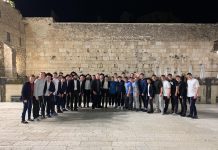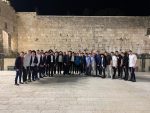By Gavriel Aryeh Sanders
Return Of The Missionaries, Part 2
Last week we informed you that missionary activities in the New York area will be on the rise this summer. Three groups in particular are currently mobilizing teams to reach Jewish areas. Jews for J commonly hosts a one-week training program for volunteer missionaries at their NYC headquarters in midtown Manhattan, followed by two weeks of outreach in July and likely another two-week push in August.
Chosen People Ministries (formerly the American Board of Missions to the Jews and founded in 1894 as the Brownsville Mission to the Jews) will conduct their one-week Shalom Brooklyn campaign July 23—30. CPM owns and operates the freshly built Charles J. Feinberg Center for Messianic Studies (previously a funeral home) on Coney Island Avenue. They have planted a very active $4.5Â million, 14,000-square-foot messianic presence in the heart of Midwood.
Third, Israel Restoration Ministries of San Diego, founded by Jewish Christian businessman Tom Cantor, will conduct a 12-week “summer blitz” in major cities with Jewish populations. Speaking of prior activity in 2012 and 2013, IRM reports: “Our teams of 145 and 114 . . . went to Brooklyn, Miami, Chicago, Philadelphia, Rochester, Portland, San Jose, Washington DC, Baltimore, Boston, and all over New Jersey knocking [on] 1.5+ million doors and distributed 500,000+ DVDs and booklets to Jewish people. Each summer IRM tells the Jewish people of the U.S. that their promised Messiah has come, fulfilled all prophecy, and is awaiting [sic] for them to receive his perfect sacrifice to atone for their sins and have a personal relationship with them.”
Tom Cantor, a Levi by birth, grew up in a non-observant Jewish home. In college, he met his non-Jewish wife. His success with Scantibodies Laboratories, a medical-products manufacturing firm, has enabled him to invest $4Â million a year on missionary outreach.
Over the last four summers, many Five Towns and Far Rockaway residents saw several of Cantor’s clean-cut young people with backpacks distributing his DVDs and booklets on doorsteps and along Central Avenue. In 2013, I spent over six hours in one-on-one and small-group dialogue with some of them, with the main objective to demonstrate from Tanach that (1) Torah-observant Jews really do have a personal relationship with Hashem and that (2) human sacrifice is not Hashem’s method of providing atonement. Did we stop them from missionizing? No. Did we create doubt and change their stereotype of Orthodox Jews? Yes, for some.
IRM will be back in New York this summer. In a Facebook posting marking Israel Independence Day, IRM announces, “Starting this week (May 11), we are going to over one million homes this summer with 120 missionaries in 20 Jewish cities.”
It’s likely they are coming to your home. Tom Cantor can afford to acquire very good mailing lists. (It’s fair to ask whether our communities should be producing local Jewish phone books that inform the world where we all live.) How should you respond when they knock on your door?
The best advice is to follow Mrs. Fried’s example mentioned in last week’s column. Don’t engage them. Just like Jews for J, they have a script. Like a good sales pitch, it’s designed to lead you down a logical path towards a decision. Moreover, they use terms common to us (God, messiah, salvation, atonement, forgiveness, repentance, faith) but which have completely different meanings. If you aren’t schooled in their special vocabulary, their theological presuppositions, their method of painting JC into the Jewish scriptures, and their zealous passion to save Jewish souls from an eternity in hell, the conversation will fall rather flat.
Reacting to them with name-calling or threats only reinforces their expectation of being persecuted for their faith. Why fuel that?
And what about the material they offer you to view and to read? Don’t take it. Let them carry it. Each one they place at a home gets tabulated for their successful distribution statistics. If you come home and find the DVD and booklet on your doorstep, toss them. There’s nothing kadosh in it.
If you do happen to spot them circulating in your neighborhood, you are welcome to let me know. If I’m available, I’d like to meet them. By the way, they are very nice people–very moral, quite disciplined, and very pious in their dedication and service. They are not cunning deceivers, as certain anti-missionary groups would portray them. They are sincere believers. From their point of view, they are giving up their summer to come share their love and concern for our souls. According to their point of view, the Jewish rejection of “the messiah” 2,000 years ago left us with a veil on our eyes, rendering us incapable of seeing “the truth” when we study Tanach.
According to Isaiah 25:7, it is actually the nations of the world that suffer from faulty vision, which will be removed in the messianic age:
וּבִלַּע בָּהָר הַזֶּה ×¤Ö¼Ö°× Öµ×™Ö¾×”Ö·×œÖ¼×•Ö¹×˜ | הַלּוֹט ×¢Ö·×œÖ¾×›Ö¼Ö¸×œÖ¾×”Ö¸×¢Ö·×žÖ¼Ö´×™× ×•Ö°×”Ö·×žÖ¼Ö·×¡Ö¼Öµ×›Ö¸×” ×”Ö·× Ö¼Ö°×¡×•Ö¼×›Ö¸×” עַל־כָּל־הַגּוֹיִ×: (“And He [Hashem] will destroy in this mountain the face of the covering that is cast over all peoples, and the veil that is spread over all nations.”) The context of this passage is in the messianic age when death will be swallowed up forever (Isa. 25:8). That clearly has not happened yet.
If I suggest that the best way to engage them is not to engage them, then why take the time in upcoming columns to point out the biblical basis for some of their interpretive errors? There are a couple of compelling reasons.
First, there may be a few Jewish missionaries among them. They have the halachic status of a “tinok she’nishba” (a captive infant). We have an obligation to help them. They are candidates to experience the warmth and kedushah of a Shabbat. If you meet any, get a name and number and say you have someone who would love to meet them and hear their story. Pass that along to me, please.
Secondly, I have long said that if we could teach a few hundred members of our community to master just a few of the major passages distorted by missionaries, it could act as a front line of defense. The missionary’s message may not appeal to you personally, but their influence may affect someone in your extended family or circle of friends.
According to Rabbi Michael Skobac, a Toronto-based Jewish educator, over 300,000 Jews in North America have embraced some form of Christianity in the last 30 years. By way of contrast, I reviewed a set of kiruv statistics (very hard to come by and even harder to rely on) which estimate that 9,000 Jews a year become observant, with about half of those being in Israel. If that’s anywhere near true, then over the last three decades, 135,000 North American Jews have embraced a more Torah-observant life while 300,000 have embraced some form of Christianity. Those are shocking numbers. But clearly not shocking enough to move those capable of acting into action.
Several Jewish organizations quote that there are 900 Christian missionary and messianic organizations targeting Jews for conversion. If we add to that just the Southern Baptist churches (over 46,000 in the U.S.) and the Assemblies of G churches (nearly 13,000 in the U.S.) as outposts advocating and funding Jewish outreach, we realize the towering height of the Goliat (Goliath) here. If you think it’s not an issue, I confirm that in my former church of 10,000 members in Los Angeles, we had over 400 Jews.
I’ll also confirm that there are not 400 Torah-observant Jews in North America–I’m not even sure if there are 40–who are trained and capable to help bring Jews from among those 300,000 back. It’s very specialized work, very labor- and time-intensive and grossly underfunded. (Lack of funding forced Jews for Judaism to recently close their East Coast office after 25 years.)
In Manhattan, Brooklyn, and Queens, there are over a dozen messianic congregations (with more upstate and on Long Island), along with the large CPM center in Midwood and the Jews for J office on Lexington in the city. And what is the New York Jewish community’s response? There is not one funded full-time person in New York, much less a full-time organization, to help Jews in the church find their way home to Torah and mitzvot. The communal lassitude on this subject is appalling. I don’t get it.
Caring askanim and nedivim have channeled hundreds of millions for kiruv rechokim (reaching Jews at a distance) and only a pittance by comparison on reaching Jews that currently believe in some version of Gd, the Bible, prayer, support of Israel, celebration of Jewish holidays, and reconnecting with Jewish culture. (I know some former messianic Jews who have become Torah-observant. They all say the same thing. Why is the Jewish community neglecting this very fertile kiruv demographic?)
When CPM’s Feinberg center in Midwood became known, there were frantic meetings between rabbis and askanim, conferences with local gedolim, newspaper articles, radio discussions, cries for action, and a few workshops. After that, silence. Ignorance, apathy, and the myth-perception of insularity resumed.
Remember the $21 million raised in 2014 by Jews for J to reach Jews? By comparison, the 2014 Form 990 of Jews for Judaism in Los Angeles, one of the better-known counter-missionary educational and counseling organizations, shows an income of only $1.2Â million. Yad L’Achim for the same period raised $1.4Â million, with most of those funds going to support programs in Israel. Aish HaTorah in the U.S., a premier kiruv operation, raised $2.19Â million in 2014 (down $1.48Â millionm from 2013 and down $4.71Â million from 2007). BJX: The Brooklyn Jewish Experience, which is attempting to make some inroads to countering missionary activity in Brooklyn, raised less than $500,000 in 2014. Subtract staff salaries, overhead, and operating costs and little is left to support programming that can make a sustaining difference.
As any accountant knows, the numbers tell the real story: Jewish giving is declining while Christian giving is increasing. If the numbers reported here are anywhere near accurate, we conclude that missionary funding is winning Jews in numbers nearly 3:1 over the kiruv movement. In this regard, there is a very real veil on Jewish eyes. No one is talking about this.
The prevailing view in the “frum velte” is that the missionary message will not appeal to a yeshiva-educated person. However, I know of a current case involving a bachur from a well-known yeshiva who spent the Pesach holiday with messianic Jews in Brooklyn. I can’t give any details, but it’s enough to say that what pushed him there was not theological but emotional. The leader of a large messianic outreach in Brooklyn was raised in the Young Israel movement. There are even some Chassidim who have quietly joined the messianic movement. These are not isolated cases. In Israel, the situation is worse today than ever. How does that happen? We’ll discuss that phenomenon in a future column.
It’s very hard for me to write about this subject. I know my words fall on mostly deaf ears. This was a hot subject in the ’70s and ’80s. Today, who cares? Well, I do. I lived in that world. I know the difference. A few readers have expressed that they care, too. Perhaps we can build on that. So next week, we’ll commence to identify some of the major passages commonly used by missionaries to “paint” JC into the Tanach. We’ll also point you to some online resources for more in-depth study. The bottom line in all this is not to battle missionaries; it’s to equip readers to help Jewish neshamot find their way home to the warm light of Yiddishkeit (יהדות). v
Gavriel Aryeh Sanders has spoken to tens of thousands of Jews across North America and abroad delivering lively lectures related to Jewish living and learning, including his autobiography on “A Minister’s Journey to Judaism.” He currently teaches Hebrew at a Long Island Jewish high school. Email: GavrielSanders@gmail.com.















